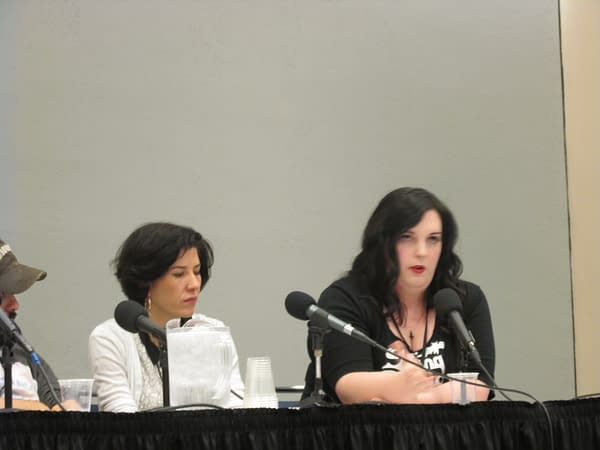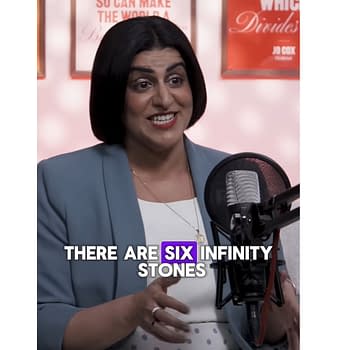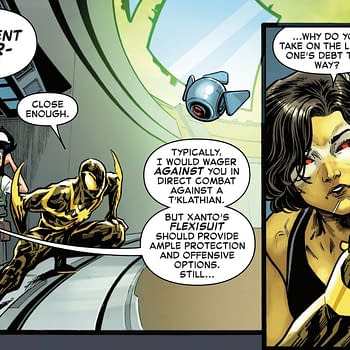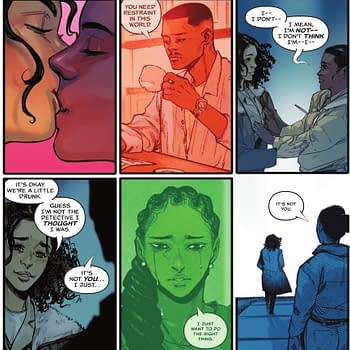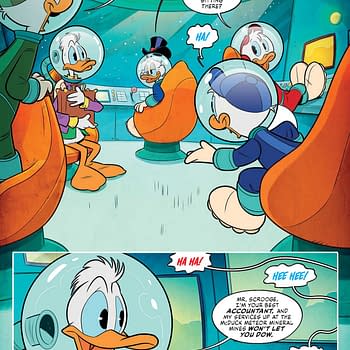Posted in: Comics | Tagged: american vampire, ben templesmith, Comics, entertainment, Heroes Con 2014, idw, in the dark, Manifest Destiny, Matt Roberts, Rachel Deering, Rafael Albuquerque, The Squidder, Vanesa del Rey
'Dark Stuff' Is All About Mood – Horror Comics With Ben Templesmith, Rafael Albuquerque, Rachel Deering, Matthew Roberts And Vanesa Del Rey At Heroes Con 2014
I haven't seen very many panels hosted recently at cons where a younger group of creators who are known for their work in horror are asked to express their feelings about the genre as a group, and articulate just what they find frightening and what their goals are in their work. Heroes Con once again proved somewhat innovative in bringing together this thematic grouping on Saturday, and it was a very interesting conversation among professionals, helping define what horror in comics means right now. Adam Daughhetee moderated a panel featuring Ben Templesmith, Rafael Albuquerque, Rachel Deering, Matthew Roberts, and Vanesa Del Rey about their life and work.
He started off by asking them, "What are your roots in horror, and what's drawn you to this genre?"
Albuquerque, who is best known right now for his work with Scott Snyder on American Vampire said that he's not really "steeped in horror culture", but is drawn to creepy and weird stuff as influenced by Frazetta, and Bernie Wrightson. He doesn't consider himself a conosseur, it's simply what he likes to draw. Most of the panelists cited Frazetta and Wrightson's influence.
Templesmith has been influenced by real-world experiences and travels, like visiting the French catacombs in Paris, finding himself attracted to the bones and smell of old places, and he simply likes "dark stuff" so that's what he draws.
Albuquerque also said "I have not really read much or seen many horror movies. It's not something I grew up consuming. However, I love the aesthetic of it" and he appreciated the opportunity to draw American Vampire, since it was something he could explore.
Rachel Deering's amusing anecdote was that she "had a weird uncle who lived in the attic" and began giving her Creepy and Eerie comics at 8 years old, her introduction to horror comics.
None of the panelists felt that horror strictly defines their work, or that it will be all they ever produce. It's something they find attractive and wish to explore, and it may even be a tendency of their style, but there are multiple genres that appeal to them.
Trying to pin down whether horror is even a "strict genre" led to some interesting teasing out of the features of horror, from recognizing its tendency toward sci-fi elements to the way in which it easily combines with other genres. That led to the need to accurately describe what horror is, and in practical terms, most saw it as a "mood" rather than a set of conventions.
Albuquerque said that American Vampire is mostly a horror book, but it depends on the era they're looking at in any given issue, and the time period in question, which might make the comic more of a Western or Spy story. Despite these alternations, it's still always horror as a base-line. "It's hard to put in words", he said, "Horror is everything that can scare or impress you. It may be psychological or maybe a thriller".
Deering, who has edited the anthology In the Dark from IDW drawing on many top talents in horror comics (with another volume in the works) explained, "Horror is a mood so you can inject it into anything. It's not whether it's in space or a Western".
Templesmith was probably joking (but who knows?) when he declared that he's going to do a horror comic about the IRS, something that could definitely evoke the "mood" that "makes you uncomfortable" by which he defines horror.
When the panelists discussed how they manage to "capture" that mood, Templesmith pointed out that the big challenge in horror comics not faced by film is the lack of sound, which is used to such affect in horror movies to change mood.
This "sensorial" lack, as Albuquerque put it, means that a lot depends on the "page turn" and plenty is about "suggestion".
Deering commented, "It becomes a more involved process of scaring yourself. You read as fast or slow as you like. You can build tension yourself, put yourself into story, and that's more fulfilling. With movies, you're just a spectator. But when reading comics, you are involved".
When asked how much the writer has to do with establishing this tension and how much is down to the artist, Albuquerque came out on the side of the artist: "I think the artist is the director and the writer is the writer. We are the ones who get the script but we tell it the way we see it. The influence we have—that's the thing. It's through our eyes that the thing is made strong".
Templesmith said, "You have to choose the shot. I don't like a really tight script where there's nothing for me to be creative about. It's my job to make it entertaining", and he added that horror really depends on true collaboration, and if there's no room in the script for details by the artist to create mood, horror is less likely to succeed.
Albuquerque said that American Vampire is "very open" and he can dialogue with Snyder if there's anything he's not comfortable with, so working without very detailed scripts is his preference and Snyder is amenable to that.
For these horror creators, they aren't often surprised by their own work and it takes a long time to appreciate it fully after it's been published because of having to think about technical problems and also from having to read the story so many times before publication. Deering suggested it takes a year to appreciate one as a creator after it's in print.
The changes in horror comics over time means that they do look back to the pre-code days for inspiration, but also have an interest in what digital comics can do when it comes to horror, often incorporating even more heightened page-turn elements and bringing out new features. Deering feels that digital "definitely helps. It can change the scene slightly, creating morphing of characters which is incredibly effective. You don't have to lead the eye away from the panel. The 8th Seal is a perfect example, or comics on Thrillbent. The more interactive you are with a comic, the more get out of it horror-wise", though she herself prefers paper to "scare" herself in her own way. Roberts, however, misses the "captions" and old Edgar Allen Poe stories of horror comics past. Templesmith joined in to say that the "thought bubble" used in older horror comics is now out of fashion but he thinks has virtue. Roberts also agreed that he prefers to "control" the page himself in print.
Questions from the floor were fielded throughout the panel, and one of the audience members asked how the panelists felt about violence, sex, and censorship in comics.
"It's stupid", said Deering, "If you don't want to see that stuff, don't read it or see it. People feel like they are entitled to decide what other people can see and handle". Templesmith added some humor, but there was a lot of truth in his observation, too: "It's very trendy to be offended these days. Everyone should just chill out. I find Brittney Spears offensive but I have to see her on the TV all the time. I've never been censored in my life. IDW have never said no to anything I've done, and I've tested that".
Other topics that cropped up were the influence of horror films (all cited examples that had an effect on them, particularly when young like Alien and The Fly), and video games, which few have time to play but most have some affinity for. Albuquerque and Roberts had been big fans of Silent Hill and found the agency in it to create "jump scare" scenes frightening.
A final hot topic was parenting choices and horror, and how much young children should be allowed to encounter horror. Roberts felt that it was never "censored" in his family, but not specifically "fostered" either, though his father was an artist and influenced him. Templesmith described himself as "sheltered" until he was allowed to stay up late watching foreign horror films and films with more sexual content. When asked whether or not there's a "set age" where children should be allowed to read work by these creators, the response was fairly unanimous that it's a personal choice of parenting and depends on the children concerned. Roberts, who has a child, says he allows "cartoony violence" in games, but not extreme games as his choice.
Look out for more Manifest Destiny from Roberts, the serialization of The Squidder from Templesmith starting imminently, a second volume of In the Dark slated for Halloween time from Deering and more American Vampire, Second Cycle from Albuquerque.




